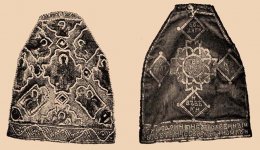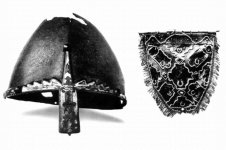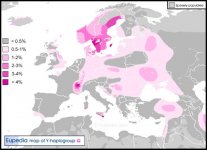gyms, Hungarians were majority Slavic speaking until the 17th century when the forced Magiarization started. There are documents in which Magiar nobles are complaing that no one speaks Magiar language. There are actually no old documents written in Magiar, only in Slavic, German and Latin. Even the coronation cap of the St Stephen of Hungary has text embroidered in Church Slavonic. Why?
Hungarians are not an example of how language and genes are not related. They are an example of how a powerful minority can force a language on a majority....Another example is forcing of the English language on the Irish...
R1a population is directly linked to Indo Arian languages...
Here is the picture of the St Stephen's coronation cap. It is currently kept in Habsburg museum in Viena:
Jesus Christ,oldeuropeanculture!
America 30 years after the end of Second World War, in 1978. Since then, the mantle has been kept in the Hungarian National Museum in special light, humidity and security conditions.
http://www.hnm.hu/en/kiall/kia_allando5.html
Is this slavic?
ANNo INcARNACIONIS XPI : MXXXI :INDICCIONE : XIIII A STEPHANO REGE ET GISLA REGINA CASULA HEC OPERATAET DATA ECCLESIAE SANCTA MARIAE SITAE IN CIVITATE ALBA.
http://www.hnm.hu/en/kiall/kia_allando5.html
The
Latin language was made official in the country—especially in the 11th to 15th centuries, the language of literature and religion was Latin. However, Hungarian was used in certain cases; sometimes it was fitted into Latin documents, to avoid later disputes about proprietary rights.
However, the first official document of Hungary is not in Latin, but in
Greek—this is the "Charter of the nuns of Veszprémvölgy",
[7] dated to 997. The text contains some Hungarian (and also some Slavic) place names: saɣarbrien (compound formed from saɣar 'shaft' + an obsolete Turkic
loanword, brien 'coalition'—today
Szárberény); saːmtaɣ 'plough'; meleɡdi (from
meleg 'warm' + -
di diminutive suffix); and so on.
The next most important document is the "
Establishing charter of the abbey of Tihany", dated to 1055. In the Latin text, 3 Hungarian sentences, 58 words, and 33 suffixes are present. The longest sentence is "fɛhɛːrvaːru reaː mɛnɛɣ hodu utu reaː" (original transcript:
feheruuaru rea meneh hodu utu rea; modern Hungarian: "
Fehérvárra menő hadi útra"—the postposition "rea", meaning "onto", became the suffix "-ra/-re"—English: 'up to the military road going to
Fehérvár'). Today, the vellum is kept in the abbey of
Pannonhalma.

Hungarian words in the founding declaration of the
Benedictine Abbey of Tihany, 1055

The Old Hungarian poem "Laments of Mary"
Skipping intermediate Hungarian relics, the next important point is the "
Funeral Sermon and Prayer", from 1192. This is the first completely Hungarian text. The document is located on the 154th page of the Codex Pray (Pray here is not English; it is a name). The sermon begins with the words "laːtjaːtuk fɛlɛim symtyxːɛl mik voɟmuk iʃaː por eʃ xomou voɟmuk"
[8]—"Do you see, my friends, what we are: truly, we are only dust and ash."
Literature in Hungarian is counted since the previous writing. The first known Hungarian poem has the title '
Laments of Mary'—its theme is the story of
Jesus' crucifixion, from the viewpoint of
Mary. It was denoted around 1300, but possibly it is not the first version—its text is clear, easy to understand and logical, free of
latinisms. The first verse:
volɛːk ʃirolm tudotlon
ʃirolmol ʃɛpɛdik
buol osuk, ɛpedɛk
| I was lament-ignorant;
I am suffering from lament,
I am suffering, languishing from sorrow.
|
The next important relic—with a cheerless history—is the "Fragment of Königsberg", dated approximately to the 1350s. This is the remain of the first known, explicitly proven Hungarian
book. The codex had arrived at
Wrocław,
Poland, by the end of the century; there, because of it was not understandable to the Polish bookbinder, it was chopped and used to bind a Latin book. The other important book from the time is the Codex Jókay; a 15th-century copy of the original from 1372. The codex is about the life of
Francis of Assisi.

A copy of the
Hussite Bible, in the Codex of Munich, dated to 1466
In the early 15th century, some not comprehensive Latin-Hungarian dictionaries—or rather word listings—were composed. Some shorter texts are also known. Regardless of these, the most important work is the first translation of the
Bible: this is the
Hussite Bible, dated to 1430. The Bible was translated by
Tamás Pécsi and
Bálint Ujlaki; both were priests. They were affected by the concepts of
Jan Hus during their university years (1399–1411) in
Prague. The
Inquisition pursued these concepts, and the translation was confiscated from the translators; anyway, it became such popular that there are several authentic copies of the original.
More and more Hungarian books were written; most of them is religious. Over and above the "Laments of Mary", the other important item of Old Hungarian poetry is the "Fight of
Šabac".
[9] Reputedly it was denoted in the year of the battle (1476); in this, Hungarian troops led by King
Matthias of Hungary had a glorious victory over the
Ottoman army—its issue is secular. Possibly it is a fragment of a longer poem. A quotation:
dɛ ɑz feʎːøːl mondot paːl keneʒi
aːroknɑk meːʎʃeːɡeːt iɡen nezi
ki ʃɑbatʃ erøːʃ voltaːt ɛlmeːlːeː
honːeːɡ minemøː aːlɟuː kel mɛlːeː
| But, Pál Kinizsi said about the thing,
who was regarding the dike's depth;
who knew the powerfulness of Šabac:
what sort of cannons should be brought from where.
|
In the 1490s, Hungarian was spoken by about 3.2 million people; this number was fairly high at the time. The first examples of official and legal use are dated back to these years. Some personal letters and wills are known. Nevertheless, the
Ottoman Empire put pressure on neighbouring nations, just like on Hungary—the latter was unstable at the time, due to internal lordship debates. This led to the Hungarian (led by
Louis II of Hungary) loss of the
Battle of Mohács (1526). In 1541, Ottomans finally captured the capital,
Buda as well. The country was split up to three parts; the southern regions fell under Ottoman rule; the western parts officially remained "Kingdom of Hungary", with Habsburg kings; and the eastern area, mainly
Transylvania and the
Partium became independent.
Some
Old Hungarian script inscriptions are also known, such as the "Alphabet of Nikolsburg" (1483) and a number of deciphered and undeciphered inscriptions. Historic linguists put the end of the Old Hungarian period to 1526, as it is a such important date in Hungarian history.
http://en.wikipedia.org/wiki/History_of_the_Hungarian_language
http://en.wikipedia.org/wiki/Funeral_Sermon_and_Prayer
http://en.wikipedia.org/wiki/Holy_Crown_of_Hungary
Yuo are not Irish.







